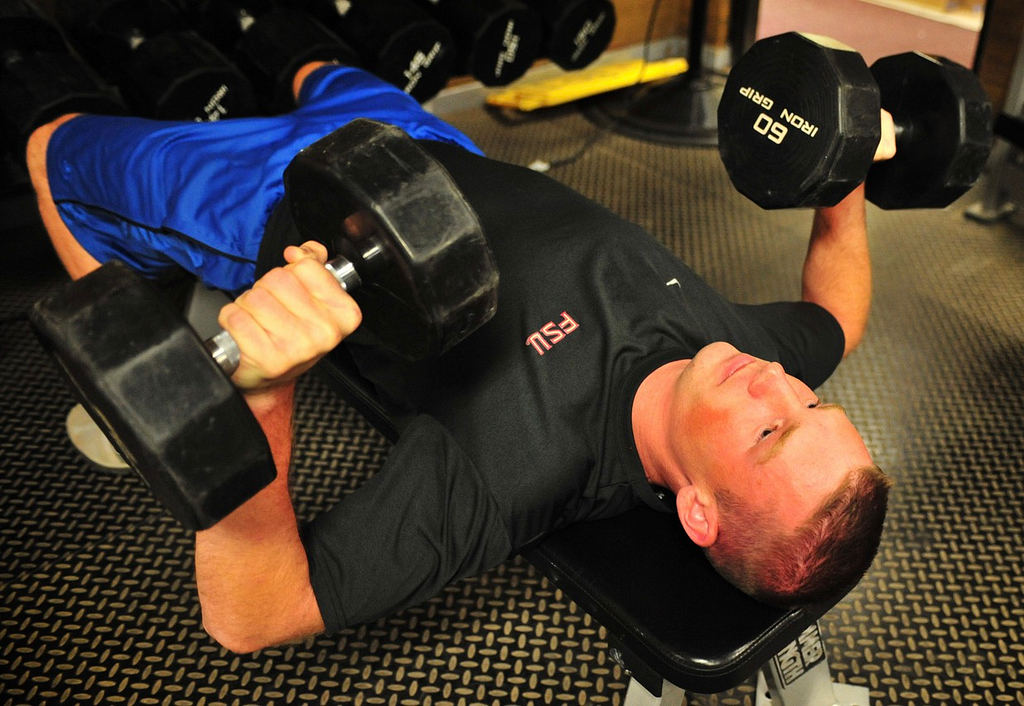Building lean vegan muscle and losing fat requires two key components: Getting your nutrition on point and following a properly structured workout routine that allows for sustainable progress over time.
We’ve all been there – jumping from routine to routine, trying out different set/rep schemes, randomly testing your 1RM in lifts, doing Zumba and hopping on the bandwagon of what’s considered the most optimal training style at the time.
Yet in the end, you’re getting nowhere. With this haphazard approach to training, you’ll inevitably fail to get the results you desire.
However, if you educate yourself and know the basic principles of how to balance factors such as exercise selection (see also ‘Isolation Exercises For Different Parts Of Your Body‘), volume, frequency, intensity, and progression, and by following a training regimen that adheres to the correct principles, you can easily take your physique to its genetic ceiling.
Well, I’m about to break all of these factors down into bite-sized chunks of information, so you can take control and yourself put together a sustainable training regime that’ll allow you put on pounds of muscle and lose fat (see also ‘ The Best Way to Lose Belly Fat Fast ‘).
(If you’re less interested in the “whys” and more into the “hows,” head over to the ‘Sample muscle-building routine’ listed below.)
Training Frequency

Frequency in the context of a training program (see also ‘P90X Review: Will It Transform Your Body?‘) can refer to two different things:
A. how often you should work out and B. how often you should work each muscle group.
How Often Should You Workout?
This is something that is ultimately going to come down to personal preference, your specific goals and training (see also ‘ Training For a Triathlon: The Best Watches, Suits, and Bikes ‘) experience, how much time you can spend in the gym, your weekly schedule, and so on and so forth. There are no right or wrong answers here – anywhere from 1-7 days per week could potentially work for you.
For those of us who have other obligations in life, such as work and school, as well as other hobbies besides the gym, like spending time with friends or playing death metal m/ – about 3-5 workouts per week will absolutely suffice for achieving your body composition goals.
How Often Should You Train Each Muscle Group?
As for B, how frequently you should train a muscle group, again it’s going to largely depend on the individual – their preferences, how their body responds to training etc.
Plant-eater X might really enjoy blasting each muscle group with tons of work once per week and get good results this way.
Plant-eater Y, on the other hand, prefers splitting up the total volume into several different sessions throughout the week. They are also seeing nice gains.

“I just love hitting my glutes every 4 days or so”
“I just love hitting my glutes every 4 days or so”
With that being said, based on the current body of evidence (one massive review examining hypertrophy (healthy bulking) [=muscle gains] from 2007 and another meta-analysis on training frequency from 2016) we can draw some conclusions for what seems to be an optimal training frequency for muscle gains (1)(2).
Here’s the gist:
It seems that a middle-of-the-road approach to training frequency, two times per week, is what promotes optimal hypertrophy.
Now as mentioned above you might see awesome results by sticking to the training (see also ‘How To Train For A Marathon As A Vegan‘) frequency you enjoy the most, whether it be 1 or 4 times per week, due to training consistency and adherence being such a crucial component to this whole “working out” thing.
Training Split

Next up is setting up a workout schedule that works for you. Your training split should be customized to allow for the frequency you desire, it should fit into your personal weekly schedule and it should take into account your training preferences and needs.
Let’s observe two different individuals that most likely will be utilizing drastically different training splits:
Person A: A teenager that loves hitting the gym, is still living at home with great recovery and nutrition in place, and with all the time in the world to hit the gym often and hard.
Person B: A new dad juggling both family duties and work at the same time, perhaps undersleeping as well as under-eating, and not having an unlimited amount of time to spend at the gym (see also ‘Choosing the Right Elliptical: Best At-Home Ellipticals Under $1,000‘).
For obvious reasons, these two individuals will follow very different training splits. Another component to picking a training split is making sure it’s not stupid.
You have to consider factors such as exercise overlap, the balance between the amount of work done for each muscle group, allowing time for rest and recovery (sleep) between sessions, and many other things that could potentially impede progress.
Here are a couple of tried-and-tested weight training schedules or splits, hopefully, you should be able to find one that you like.
2-day Full Body Split
Monday: Full Body Workout
Tuesday: off
Wednesday: off
Thursday: Full Body Workout
Friday: off
Saturday: off
Sunday: off
3-day Push/Pull Split
Monday: Legs, Chest, Shoulders & Triceps
Tuesday: off
Wednesday: Hamstrings, Back & Biceps
Thursday: off
Friday: Legs, Chest, Shoulders & Triceps (see also ‘Improving Your Triceps And Quads Using Weight Plate Exercises’)
Saturday: off
Sunday: off
Next week consisting of 2 pull sessions and 1 push session, alternating between the two weeks.
4-day Upper/Lower Split
Monday: Lower Body Workout
Tuesday: Upper Body Workout
Wednesday: off
Thursday: Lower Body Workout (see also ‘ 5 Fun Track Workouts You Can Do On A Vegan Diet’ )
Saturday: off
Sunday: off
Rotating Legs/Push/Pull Split
Monday: Legs & Abs (see also ‘What is The Best Way to Use an Ab Roller?‘)
Tuesday: Chest, Shoulders & Triceps
Wednesday: off
Thursday: Back & Biceps (see also ‘Bicep Exercises: Stretches and Routines To Strengthen Your Biceps‘)
Friday: off
Saturday: Legs & Abs
Sunday: Chest, Shoulders & Triceps
Following a rotating legs/push/rest/pull/rest pattern.
The “Bro-Split”
Monday: Chest
Tuesday: Back
Wednesday: Legs & Abs
Thursday: Shoulders
Friday: Arms
Saturday: off
Sunday: off
Intensity (Rep Scheme)

Simply put, the term intensity refers to the amount of weight lifted. Lower intensity means lighter loads used and vice versa for higher intensity.
In the context of a workout, the intensity is going to predict how many reps or repetitions you can perform on a given exercise – using a higher intensity will yield lower reps and vice versa. There are some distinct advantages to using different rep ranges and intensities.
Here are some general guidelines for rep ranges and their primary training effect:
- check Working at a high intensity of 90-100%, which equals around 1-4 reps, will mainly promote strength (neural) gains.
- check Working at a a low intensity of <60%, 20+ reps, will mainly promote muscle endurance gains (see also ‘Can Endurance Training Build Muscle?‘).
- check Working at a moderate intensity of 70-85%, about 6-12 reps or so, is going to yield the most effective hypertrophic effect due to the time under tension and mix of both metabolic and strength adaptation.
Now, these rep ranges aren’t distinctly separated, but rather exist on a continuum with quite a bit of overlap. Performing 10 reps will still promote some neural adaptation, but not nearly to the same degree as a 1RM lift and vice versa.
If you would have to pick one rep range only for making gains it would probably be 6-12 reps.
Anecdotally, this is where many bodybuilders spend the majority of their time, and the comprehensive meta-analysis (3) on hypertrophy that I referenced before also suggests that this is the most efficient intensity range for building muscle.

Now, don’t be afraid of straying outside of the 6-12 rep range from time to time. There’s evidence indicating that muscle gains are also possible at many different loads, for instance, if you take a set at 30% intensity to failure it’s still going to promote hypertrophy (4).
Some exercises (see also ‘What Are The Benefits Of Swimming?‘) just work better within a lower rep range of perhaps 3-6 reps, and lower reps also produce full muscle fiber recruitment fro§m the very first rep. Other isolation exercises might be more suited to the 20+ rep range which can also help inject some novel training stimulus.
Should I Go To Failure?
So is it necessary to go to failure? By this, I mean lifting until your form breaks down or you can’t perform the last rep and someone has to come help you while the bar is suffocating you.
Short answer: no.
Slightly longer answer: Going to failure will produce a lot of unnecessary fatigue and might increase your risk of injury (see also ‘ 10 Best Ways To Exercise With A Bad Knee ‘). Using the measure repetitions in reserve (RIR), you should aim for 1-2 RIR when terminating the set.
Still, going to failure on isolation movements using higher reps is more forgiving than say, a 3 rep squat, and is probably not the end of the world (I do it quite frequently)
Training Volume

There are various ways of defining training volume:
You might encounter it described as either quantity of reps per session, reps per week, total tonnage (reps x sets x weight lifted) or amount of ‘hard sets’ done per week.
In case you haven’t encountered the terminology before – sets means how many times you repeat an exercise (see also ‘How to Get a Butt that Jiggles: 11 Exercises‘) for a certain number of reps. For example, 3×10 (sets x reps) means you do 3 sets of 10 repetitions. Regardless of how we choose to define it, performing the correct training volume is a key factor for promoting muscle growth.
So what would be considered ‘optimal training volume’? Be warned, asking this particular question is like opening up pandora’s box.
Proponents of HIT (high-intensity training) will say that only 1 set to failure is the best method for gaining muscle, and on the other side of the fence, high volume fanatics will tell you that blasting each muscle with 30 sets per week is the only surefire path to gains.
So let’s look to the available body of scientific research to try and sort this out.
How Much Volume for Optimal Gains?

The same meta-analysis from 2007 examining hypertrophy also summarized takeaway points for training volume and muscle growth (5):
“Overall, moderate volumes (≈30–60 repetitions per session for DER [Dynamic External Resistance] training) appear to yield the largest responses.” (Note that this is within the intensity range of 60%-85% of 1RM, or ~6-20 reps taken to, or within failure)
Another meta-analysis on the subject (Schoenfeld et al 2016) indicates that there’s a dose-response relationship between volume and greater gains in muscle mass where (6):
Less than 5 weekly sets per week provided 5.4% gains,
5-9 weekly sets = 6.6% gains,
and 10 or more sets = 9.8% gains.
So it does seem to be the case that a higher training volume also produces a greater hypertrophic effect. However, that doesn’t mean that jacking up training volume to 50 sets per week is a good strategy – and while you do need to do enough work to stimulate growth, doing too much can actually inhibit growth.
There’s a certain amount of work that will adequately stimulate the muscle (see also ‘Strengthening Your Rhomboid And Surrounding Neck Muscles‘), and beyond this point, more work will only generate unnecessary fatigue and possibly even increase the risk of injury and overtraining. A good analogy is to think of it as hammering a nail into a wooden board:
Two or three precise hits will get the job done. Spending 5 more minutes battering the board will not yield any better results – you might just ruin the damn thing.

Just 84 times more and this should work
Furthermore, these reviews on training volume only report the means of the subjects, some individuals will thrive on higher volume while some will thrive on lower volume.
Anyways, here’s the bottom line for training volume:
- check 30-60 reps per session maximizes the growth response
- check Anywhere from 5 to 10+ hard sets per muscle group per week will produce good gains.
Exercise Selection

Proper exercise selection is another important component of designing your workout plan. If your workout regimen revolves around ineffective exercises (see also ‘Hand Exercises To Improve Strength And Dexterity‘), you’ll severely limit your rate of gains.
What makes this difficult is that there’s an almost infinite number of lifts to choose from, so how are you supposed to know which ones yield the best results?
To get the best return on investment from your training, you ought to follow a couple basic guidelines:
Perform Mainly Compound Exercises
The foundation for any effective weight training program is compound exercises. A compound exercise involves multiple joints and muscle groups, for example, the squat and the bench press are both compound lifts.
There are several reasons why these exercises should form the bulk of your routine:
- check They train many muscles at once. A compound exercise can effectively engage many muscles at once with one exercise – which means they build more overall muscle and give you a big return on investment, so to speak.
- check They allow you to lift heavy weights. And heavier weights means a larger stimulus for the muscles and a greater incentive for them to grow big and strong.
- check Tremendous potential for weight progression. As compound movements utilizes many muscle groups it means there’s a greater potential for weight progression = more gains.
Say for example that you want to build a well-developed chest:
Adding 60 pounds to your dumbbell bench press is going to result in much more gains (SARMS Results) than 10 pounds to dumbbell flyes (and your triceps and front delts will also thank you for it).
Use Isolation Exercises Intelligently
Isolation exercises (see also ‘Neck Mobility: Exercising Your Sternocleidomastoid‘) are movements that isolate and work out one muscle group
(what is Powerflow Yoga). While they don’t provide quite the same bang for your buck as compound movements, isolation exercises can still serve a useful purpose in a training program.
Say for example you’re working your back (see also our favorite spinal decompression exercises).
After some heavy sets of chin-ups and rows, you also need to specifically fit in some additional volume for the biceps. In this situation, there’s really only one alternative – an isolation movement – in this case, some sort of bicep curl.
This is how you implement isolation exercises (see also ‘The Best Waist Training Exercises‘) intelligently – by supplementing your heavy compounds with carefully selected isolation work.
A rule of thumb is that the majority of sets (80%+) performed should be compounds, with the rest being isolation movements (20%)
What Exercises Should I Do?
Exercises can be divided into 6 basic movement patterns (7 with arms included).
A well-balanced training routine (See Yoga) should include exercises from each andevery movement pattern.
Quad dominant
- check Squats
- check Front squats
- check Machine/hack squats (see also ‘Different Squat Techniques: How To Accomplish The Best Squat’)
- check Leg press
- check Lunge variations
- check Leg extensions
Hamstring/hips dominant
- check Deadlifts
- check Barbell/dumbell romanian deadlifts
- check Barbell hip thrust
- check Good mornings
- check tcb-no-delete”>Glute ham raise (see also ‘Exercises To Tone Your Buttocks‘)
- check Reverse hyper
- check Leg curl
Horizontal push
- check Incline/flat/decline bench press
- check Incline/flat/decline dumbbell bench press (see also ‘Barbell Vs. Dumbbell: How to Enhance Your Press Techniques‘)
- check Incline/flat/decline chest press machine (see also ‘ 10 Best Compact Home Gym Machines’ )
- check Incline/flat/decline machine or dumbbell flyes.
- check Dips
- check Push-ups
Horizontal pull
- check Barbell rows
- check Dumbbell rows
- check T-Bar rows
- check Seated cable rows
- check Chest-supported rows
- check Inverted rows
- check Any other row variation
Vertical Push
- check Standing overhead barbell/dumbbell press
- check Seated overhead barbell/dumbell press
- check High incline press
- check Side lateral raise
- check Upright barbell/dumbell row
Vertical Pull
- check Chin-ups
- check Pull-ups
- check Wide and close-grip lat pull-downs
Arms
- check Barbell curls
- check Dumbbell curls
- check Machine curls ( reviewing the Bowflex system)
- check Tricep pressdowns
- check Tricep extensions
For exercises like squat variations, deadlifts, overhead press, and bench press, you can also use powerlifting belts to boost your lifting performance.
Progressive Overload

Thus far, we’ve looked at different training parameters such as training frequency, the workout split you use, intensity, rep schemes, training volume and exercise (see also ‘Safe Exercises To Do With a Herniated Disc’) selection. Surely that should be enough to design a decent workout routine, right?
Well, not quite.
There’s one last missing piece of the puzzle that will ultimately dictate if you’re going to be spinning your wheels and never reaching your body composition goals, or get the muscular development you want at the fastest rate.
That missing piece is progressive overload, which basically means that you have to continually challenge, or overload, your muscles in order to make gains. To become bigger and stronger, you cannot be doing the same thing over and over in the gym while expecting your muscles to grow.
It makes a lot of sense when you think about it:
Your muscles are only going to grow if you challenge them and consistently push them beyond their usual limits; otherwise, they’re just going to stay the same.
The most common method of achieving progressive overload is by adding weight. So if you did 3 x 10 reps of 110 lbs on the bench press, try to do 3 x 10 reps of 115 lbs the next workout. Voila, you’ve overloaded the muscles.
Other viable strategies include:
More reps. Instead of 3 x 10 reps of 110 lbs on the bench press, try to do 3x11 at 110 lbs for your next workout.
More sets. Try to do 4x10 at 110 lbs next time instead.
Less rest time. If you tend to give yourself a 3-minute rest break between your sets, trying doing the same sets but giving yourself just 2.5 minutes to rest instead.
Play it on hard mode. You could also keep the conditions the same, but just make the exercise itself more difficult. For instance, pause your reps at the bottom, slow down your rep tempo, or use a technique which is known to be more challenging.
Vegan Muscle-Building Routine
We now have a pretty comprehensive toolkit to design a great workout routine:
- check Work out each muscle group twice a week.
- check Work a balanced training split into your schedule.
- check Utilize an intensity of around 60-85% or 5-20 reps (doing 6-12 reps mostly).
- check If you’re looking for volume, try 30-60 reps per session per muscle group and/or 5 to 10+ hard sets per week per muscle group.
- check Base your regimen on supplemental isolation movements with compound lifts.
- check Overload your muscles progressively.
Now obviously, it’s very hard to create a routine which perfectly aligns with everyone’s personal needs, genes, goals, wishes, hopes, and dreams, but we can still create a guideline routine which should be suitable for most people, if not everyone.
This article on how much protein vegans need to build muscle might also interest you.
Here are some reasons that you should care about it:
A. It takes no more than 4 hours per week, so you can fit it into your life seamlessly.
B. It has a moderate volume and frequency designed to work slowly over time without tiring you out or causing you to become demotivated.
C. There’s a balance of workouts which should give you that evenly-toned Adonis physique
D. It’s ideal for both novice and mid-level vegan lifters (see also ‘ What Are The Best Supplements to Take For Lifters ?’)
Something along the lines of this is going to be very effective for putting on mass in a bulking phase (or retain muscle during cutting):
Workout A1: Chest, Back (check our favorite back exercises to reduce lumbar stress), Shoulders & Triceps
1. Incline Bench Press
3 sets of 6-8 reps
~3 min rest between sets
2. Barbell Row
3 sets of 6-8 reps
~3 min rest between sets
3. Dips
2 sets of 10-12 reps
~2 min rest between sets
4. Wide-Grip Lat Pulldown
2 sets of 10-12 reps
~2 min rest between sets
5. Side Lateral Raise
2 sets of 12-15 reps
~1.5 min rest between sets
6. Face Pulls
2 sets of 12-15 reps
~1.5 min rest between sets
7. Tricep Pressdown
2 sets of 12-15 reps
~1.5 min rest between sets
Workout B1: Quads, Hamstrings, Calves, Abs & Biceps
1. Squat or Front Squat
3 sets of 6-8 reps
~3 min rest between sets
2. Split Squat
3 sets of 10-12 reps
~2 min rest between sets
3. Leg Curl
2 sets of 10-12 reps
~2 min rest between sets
4. Standing Calf Raise
~2 sets of 10-12 reps
2 min rest between sets
5. Barbell Curl
~2 sets of 12-15 reps
1.5 min rest between sets
6. Abs
Couple sets of ~15 reps
~1.5 min rest between sets
Workout A2: Chest, Back, Shoulders (see compound) & Triceps
1. Overhead Barbell Press
3 sets of 6-8 reps
~3 min rest between sets
2. Chin-ups
3 sets of 6-8 reps
~3 min rest between sets
3. Dumbbell Bench Press
2 sets of 10-12 reps
~2 min rest between sets
4. Dumbbell or Chest-Supported Rows
2 sets of 10-12 reps
~2 min rest between sets
5. Chest Flyes
2 sets of 12-15 reps
~1.5 min rest between sets
6. Reverse Flyes
2 sets of 12-15 reps
~1.5 min rest between sets
7. Lying Tricep Extension
2 sets of 12-15 reps
~1.5 min rest between sets
Workout B2: Quads, Hamstrings, Calves, Abs & Biceps
1. Deadlifts
3 sets of 4-6 reps
~3 min rest between sets
2. Leg Press
3 sets of 10-12 reps
~2 min rest between sets
3. Leg Curl
2 sets of 10-12 reps
~2 min rest between sets
4. Sitting Calf Raise
2 sets of 10-12 reps
~2 min rest between sets
5. Alternating Dumbbell Curl
2 sets of 12-15 reps
~1.5 min rest between sets
6. Abs
Couple sets of ~15 reps
~1.5 min rest between sets
On a weekly basis this will look like:
Monday: Workout A1
Tuesday: off
Wednesday: Workout B1
Thursday: off
Friday: Workout A2
Saturday: off
Sunday: off
And the next week:
Monday: Workout B2
Tuesday: off
Wednesday: Workout A1
Thursday: off
Friday: Workout B1
Saturday: off
Sunday: off
Keep on rotating through the workouts in this manner. Another alternative if you’ve got the time is to perform all four workouts in one week (please note that this is completely optional):
Monday: Workout B1
Tuesday: Workout A1
Wednesday: off
Thursday: Workout B2
Friday: Workout A2
Saturday: off
Sunday: off
How do I progress?
Say you perform 3×10-12 on the leg press (see also ‘The Benefits Of The Leg Press Machine‘) with 200 lbs and your sets look like:
Set 1: 12 reps
Set 2: 12 reps
Set 3: 11 reps.
Perfect, you hit the top end of the range on the first set and got all subsequent sets within the rep range of 10-12, so you can then add more weight the next session. Next time around, you do 210 lbs and get 12,10,10. Add weight.
Next session you do 220 lbs and get 10,9,9. Seeing as you didn’t hit the top end of the range and the subsequent sets fell outside, stay on this weight for the next session.
Next session you absolutely kill 220 lbs and get 12,12,12 which means you can add weight next session, and so on.
Don’t get discouraged if you’re not able to add weight every single session. Strength gains (see also ‘Are Weight Gainers Safe to Use?‘) aren’t linear and sometimes you’re stuck on a certain weight for a while until it decides to move again.
How do I warm-up?
Before anything, do some light cardio for around 5 minutes (becoming an ultra runner). This will raise your body temperature and get you more loosened up and ready to go.
Then, perform the agile 8 circuit before a lower body workout.
Perform 2 sets of wall slides, band pull-aparts, and chins before an upper body workout (see also ‘Upper Body Cardio And Strength Exercises’). Here’s an example:
If you’re getting warmed up (see also ‘Best Achilles Stretches For Runners‘) for a particular workout, then do a few lighter sets of this specific exercise before switching to the more intensive and heavy sets.
As an example, if you were planning to eventually do a 135-pound incline bench press, but you wanted to warm your way up to it, you could try this:
- Set 1: 45 lbs x 10
- Set 2: 45 lbs x 10
- Set 2: 90 lbs x 8
- Set 3: 110 lbs x 5
And then finally move on to the head honcho – 135 lb sets!
In general, exercises (see also ‘Using Bodyblade Exercises For Rehabilitation‘) which have bigger movements involved require more warming up, as well as exercises which are being carried out early in the morning when your body is still waking up and not quite “with it” yet. On the other hand, if you’re doing less intense isolation movements in your workout, these usually require less warming up (see also ‘The Ultimate Stretching Routines for Runners‘).
So that’s it for this article, thanks for checking it out!
Remember, nutrition is really important when working out. I guess that’s why they say 80% of your results comes from the kitchen and 20% comes from the gym.
Read our full article on getting the right macros in your diet for any vegan athlete.
Please share in the comment section what workout routine (see also ‘A Guide To Using Jump Exercises In Your Workout Routine‘) you prefer.
[tcb-script type=”application/ld+json”]{“@context”: “http://schema.org/”,”mainEntityOfPage”: “https://veganliftz.com/build-workout-routine/”,”@type”: “Article”,”headline”: “How to Create a Workout Routine? – 6-Step Guide to Building Your Program”,”datePublished”: “2018-07-14″,”dateModified”: “2019-11-05″,”description”: “Learn exactly how to build a workout routine with optimal volume/frequency/intensity/rest so you can accelerate your vegan muscle gains! We found out that…”,”keywords”: [“building a workout plan”, “how to build a workout routine”, “how to build a workout plan”, “build a workout plan”, “make a workout plan”, “vegan workout plan”],”image”: {“@type”: “ImageObject”,”height”: “379”,”width”: “725”,”url”: “https://mlbmbvodvbvn.i.optimole.com/w:auto/h:auto/q:100/f:best/https://veganliftz.com/wp-content/uploads/2018/07/How-to-build-an-awesome-workout-routine-featured-image.jpg”},”author”: “Jason Hughes”,”publisher”: {“@type”: “Organization”,”name”: “Vegan Liftz”,”sameAs”:[“https://www.facebook.com/veganliftz/”,”https://twitter.com/veganliftz/”,”https://www.pinterest.com/veganliftzofficial/”,”https://www.instagram.com/veganliftz/”,”https://www.youtube.com/channel/UCVilJCjZsaI1Q50fbM_IsnQ”,”https://goo.gl/maps/sC3u4cuyWLqYwhBY7″],”logo”: {“@type”: “ImageObject”,”url”: “https://mlbmbvodvbvn.i.optimole.com/w:auto/h:auto/q:100/f:best/https://veganliftz.com/wp-content/uploads/2019/04/Veganliftz_White_Small.png”}}}[/tcb-script]
References:
1) Wernbom, M., Augustsson, J., & Thomeé, R. (2007). The influence of frequency, intensity, volume and mode of strength training
(see calisthenics) on whole muscle cross-sectional area in humans. Retrieved from https://www.ncbi.nlm.nih.gov/pubmed/173266982) Schoenfeld, B. J., Ogborn, D., & Krieger, J. W. (2016, November). Effects of Resistance Training Frequency on Measures of Muscle Hypertrophy: A Systematic Review and Meta-Analysis. Retrieved from https://www.ncbi.nlm.nih.gov/pubmed/271021723) Wernbom, M., Augustsson, J., & Thomeé, R. (2007). The influence of frequency, intensity, volume and mode of strength training on whole muscle cross-sectional area in humans. Retrieved from https://www.ncbi.nlm.nih.gov/pubmed/173266984) Mitchell, C. J., Churchward-Venne, T. A., West, D. W., Burd, N. A., Breen, L., Baker, S. K., & Phillips, S. M. (2012, July 01). Resistance exercise load does not determine training-mediated hypertrophic gains in young men. Retrieved from https://www.ncbi.nlm.nih.gov/pmc/articles/PMC3404827/5) Wernbom, M., Augustsson, J., & Thomeé, R. (2007). The influence of frequency, intensity, volume and mode of strength training on whole muscle cross-sectional area in humans. Retrieved from https://www.ncbi.nlm.nih.gov/pubmed/173266986) Schoenfeld, B., Ogborn, D., & Krieger J. Dose-response relationship between weekly resistance training volume and increases in muscle mass: A systematic review and meta-analysis. (2016, July). Retrieved from: https://www.researchgate.net/publication/305455324_Dose-response_relationship_between_weekly_resistance_training_volume_and_increases_in_muscle_mass_A_systematic_review_and_meta-analysis
- Why is My Poop Black: Uncovering the Causes and Solutions - December 21, 2023
- Clear Protein Drinks: Optimal Hydration and Muscle Support for Athletes and Fitness Enthusiasts - December 21, 2023
- Does Apple Juice Make You Poop: Uncovering the Digestive Effects - November 29, 2023








